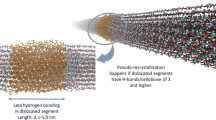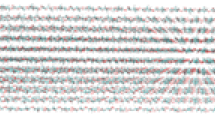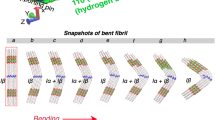Abstract
The conformation of cellulose microfibrils treated with aqueous NaOH was modeled as partially decrystallized cellulose chains before completing conversion to cellulose II, in order to elucidate the change in morphology of ramie fiber caused by NaOH treatment. Equations for the relative length and width of the microfibrils were derived on the basis of partially decrystallized microfibrils modeling. Each equation contains four parameters, n, β, w c , and c r , which correspond to the number of glucose residues between periodic defects along the untreated ramie cellulose microfibrils, the extension ratio of amorphous cellulose chain along length, the cross-section crystallinity, and the correction term of crystallinity, respectively. The validity of the derived equations was confirmed by two types of simulations. One is performed using experimental data L/L 0 and W/W 0 as a function of crystallinity, while the other is done using the relationship between the relative length and width obtained from the experimental data, which is independent of crystallinity, was performed. The best-fit simulation was obtained under n = 277, β = 2.813, and c r w c = 0.671 for the former and under n = 301 and β = 2.792 for the latter. These values of n and β correspond closely to the values reported in references for ramie microfibrils. Both simulation results show that macroscopic changes in the morphology of ramie fibers is attributable to the changes in cellulose chain conformation in the decrystallized regions created along the microfibrils upon NaOH treatment.






Similar content being viewed by others
References
Okano T, Sarko A (1984) Mercerization of cellulose I: X-ray diffraction evidence for intermediate structures. J Appl Polym Sci 29:4175–4182
Okano T, Sarko A (1985) Mercerization of cellulose II: alkali-cellulose intermediates and a possible mercerization mechanism. J Appl Polym Sci 30:325–332
Hayashi J, Yamada T, Shimizu YL (1989) Memory phenomenon of the original crystal structure in allomorphs of Na-cellulose. In: Schuerch C (ed) Cellulose and wood: chemistry and technology proc. Of the tenth cellulose conf. John Wiley and Sons, New York, pp 77–102
Nishimura H, Okano T, Sarko A (1991) Mercerization of cellulose 5: crystal and molecular structure of Na-cellulose I. Macromolecules 24:759–770
Nishimura H, Okano T, Sarko A (1991) Mercerization of cellulose 6: crystal and molecular structure of Na-cellulose IV. Macromolecules 24:771–778
Nishiyama Y, Okano T (1998) Morphological changes of ramie fiber during mercerization. J Wood Sci 44:310–313
Kamide K, Okajima K, Kowsaka K (1985) CP/MASS 13C NMR spectra of cellulose solids: an explanation by the intramolecular hydrogen bond concept. Polym J 17:701–706
Kamide K, Kowsaka K, Okajima K (1985) Determination of intramolecular hydrogen bonds and selective coordination of sodium cation in alkali cellulose by CP/MASS 13C. Polym J 17:707–711
Kamide K, Okajima K, Kowsaka K (1985) Dissolution of natural cellulose into aqueous alkali solution: role of super-molecular structure of cellulose. Polym J 24:71–86
O’sullivan AC (1997) Cellulose: the structure slowly unravels. Cellulose 4:173–207
Roy C, Budtova T, Navard P, Bedue O (2001) Structure of cellulose – soda solutions at low temperature. Biomacromolecules 2:687–693
Cai J, Zhang L (2006) Unique gelation behavior of cellulose in NaOH/urea aqueous solution. Biomacromolecules 7:183–189
Cai J, Zhang L, Chan C, Cheng G, Chen X, Chu B (2007) Hydrogen-bond-induced inclusion complex in aqueous cellulose/LiOH/Urea solution at low temperature. Chem Phys Chem 8:1572–1579
Cai J, Zhang L, Zhou J, Qi H, Chen H, Kondo T, Chen X, Chu B (2007) Multifilament fibers based on dissolution of cellulose in NaOH/urea aqueous solution: structure and properties. Adv Mater 19:821–825
Shibazaki H, Kuga S, Okano T (1997) Mercerization and acid hydrolysis of bacterial cellulose. Cellulose 4:75–87
Shibazaki H, Saito M, Kuga S, Okano T (1998) Native cellulose production by acetobacter xylinum under physical constrain. Cellulose 5:165–173
Le Moigne N, Spinu M, Heinze T, Navard P (2010) Restricted dissolution and derivatization capacities of cellulose fibres under uniaxial elongational stress. Polym 51:447–453
Kroon-Batenburg LMJ, Kruiskamp PH, Vliegenthart JFG, Kroon J (1997) Estimation of the persistence length of polymers by MD simulations on small fragmentsin Solution: Application to cellulose. J Phys Chem B 101:8454–8459
Chen W, Lickfield GC, Yang CQ (2004) Molecular modeling of cellulose in amorphous state part I: model building and plastic deformation study. Polym 45:1063–107
Queyroy S, Müller-Plathe F, Brown D (2004) Molecular dynamics simulation of cellulose oligomers: conformational analysis. Macromol Theor Simul 13:427–440
Eichhom SJ, Young RJ, Davies GR (2005) Modeling crystal and molecular deformation in regenerated cellulose fiber. Biomacromolecules 6:507–513
Shen T, Langan P, French AD, Johnson GP, Gnanakaran S (2009) Conformational flexibility of soluble cellulose oligomers: chain length and temperature dependence. J Am Chem Soc 131:14786–14794
Hanus J, Mazeau K (2006) The xyloglucan-cellulose assembly at atomic scale. Biopolymers 82:59–73
Bocahut A, Delannoy JY, Vergelati C, Mazeau K (2014) Conformational analysis of cellulose acetate in the dense amorphous state. Cellulose 21:3897–3912
Srinivas G, Cheng X, Smith JC (2014) Coarse-grain model for natural cellulose fibrils in explicit water. J Phys Chem B 118:3026–3034
Nakano T (1988) Plasticization of wood by alkali treatment: effects of kind of alkali and concentration of alkaline aqueous solution on stress relaxation (in Japanese). Nihon Reoroji Gakkaishi (J Soc Rheol Japan) 16:104–110
Nakano T (1989) Plasticization of wood by alkali treatment: relationship between plasticization and the ultra-structure (in Japanese). Mokuzai Gakkaishi (J Japan Wood Res Soc) 35:431–437
Nakano T, Sugiyama J, Norimoto M (2000) Contraction force and transformation of microfibril with aqueous sodium hydroxide solution. Holzforschung 54:315–320
Nakano T (2010) Mechanism of microfibril contraction and anisotropic dimensional changes for cells in wood treated with aqueous NaOH solution. Cellulose 17:711–719
Nakano T, Tanimoto T, Hashimoto T (2013) Morphological change induced with NaOH-water solution for ramie fiber: change mechanism and effects of concentration and temperature. J Mater Sci 48:7510–7517
Nakano S, Nakano T (2014) Change in circularity index of cell lumen in cross-section of wood induced by aqueous NaOH. J Wood Sci 60:99–104
Nakano S, Nakano T (2015) Morphological changes induced in wood samples by aqueous NaOH treatment and their effects on the conversion of cellulose I to cellulose II. Holzforschung 69:483–491
Tanimoto T, Nakano T (2012) Stress relaxation of wood partially non-crystallized using aqueous NaOH solutions. Carbohydr Polym 87:2145–2148
Tanimoto T, Nakano T (2013) Side-chain motion of components in wood samples partially no-crystallized using NaOH-water solution. Mater Sci Eng C 33:1236–1241
Tanimoto T, Nakano T (2015) Difference in reduction properties between longitudinal dimension and elastic modulus of wood induced with aqueous NaOH treatment: modeling and analysis. J Wood Sci 62:12–19
Miura K, Nakano T (2015) Analysis of mercerization process based on the intensity change of deconvoluted resonances of 13C CP/MAS NMR: cellulose mercerized under cooling and noncooling conditions. Mater Sci Eng C 53:189–195
Miura K, Nakano T (2016) Analysis of the effects of restriction of longitudinal contraction on the conversion from cellulose I to cellulose II using CP/MAS 13C NMR: Mercerization of ramie fibers under noncooling and cooling conditions. J Mater Sci 51:6331–6340
Fink H-P, Philipp B (1985) Models of cellulose physical structure from the viewpoint of the cellulose I → II transition. J Appl Polym Sci 30:3779–3790
Benoit H (1947) Sur la statique des chains avec interactions et empechements ateriques. J Chem Phys 44:18–21
Nishiyama H, Kim U, Kim D, Katsumata K, May RP, Langan P (2003) Periodic disorder along ralmie cellulose microfibrils. Biomacromolecules 4:1013–1017
Slater GW, Gratton Y, Kenward M, Mccormick L, Tessier F (2004) Deformation, stretching, and relaxation of single-polymer chains: fundamental and examples. Soft Mater 2:155–182
Nishino T, Takano K, Nakamae K, Saitaka K, Itakura S, Azuma J, Okamura K (2008) Elastic modulus of the crystalline regions of cellulose triesters. J Polym Sci 33:611–618
Gindl W, Reifferscheid M, Adusumalli R-B, Weber H, Röder T, Sixta H, Schöberl T (2008) Anisotropy of the modulus of elasticity in regenerated cellulose fibers related to molecular orientation. Polymer 49:792–799
Nakamura K, Wada M, Kuga S, Okano K (2004) Poisson’s ratio of cellulose Iβ and cellulose II. J Polym Sci B 42:1206–1211
Author information
Authors and Affiliations
Corresponding author
Rights and permissions
About this article
Cite this article
Nakano, T. Modeling of the morphological change of cellulose microfibrils caused with aqueous NaOH solution: the longitudinal contraction and laterally swelling during decrystallization. J Mol Model 23, 129 (2017). https://doi.org/10.1007/s00894-017-3307-y
Received:
Accepted:
Published:
DOI: https://doi.org/10.1007/s00894-017-3307-y




